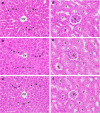In vivo assessment of the antimalarial activity and acute oral toxicity of an ethanolic seed extract of Spondias pinnata (L.f.) Kurz
- PMID: 35296314
- PMCID: PMC8928678
- DOI: 10.1186/s12906-022-03546-9
In vivo assessment of the antimalarial activity and acute oral toxicity of an ethanolic seed extract of Spondias pinnata (L.f.) Kurz
Abstract
Background: In response to the persistent problem of malaria resistance, medicinal herbal plants can be used as a source of potential novel antimalarial agents. Therefore, the aim of this study was to evaluate the in vivo antimalarial activity and toxicity of an ethanolic seed extract of Spondias pinnata (L.f.) Kurz (S. pinnata).
Methods: Qualitative phytochemical screening of the extract was performed using standard procedures, and the constituents were determined by gas chromatography-mass spectrometry (GC-MS). The in vivo antimalarial activity was assessed against the Plasmodium berghei ANKA strain in mice based on 4-day suppressive, curative and prophylactic tests. In addition, the acute toxicity of the extract was evaluated after oral administration of a single dose of 2,000 mg/kg body weight.
Results: Phytochemical screening tests on the ethanolic S. pinnata seed extract revealed the presence of terpenoids, tannins, and coumarins. GC-MS analysis of the extract led to the identification of twenty-nine phytochemical compounds, including oleic acid amide, β-sitosterol, linoleic acid, oleic acid, protocatechuic acid, syringic acid and gallic acid. The results of the 4-day suppressive test revealed that mice treated with 250, 500, 600 and 800 mg/kg doses of the ethanolic S. pinnata seed extract showed significant parasitemia suppression in a dose-dependent manner, with 22.94, 49.01, 60.67 and 66.82% suppression, respectively, compared to that of the negative control group. All the doses of the ethanolic seed extract significantly suppressed parasitemia (P < 0.05) during the curative activity test and prolonged the mean survival time compared to those of the negative control group. However, the ethanolic seed extract displayed lower curative and prophylactic activities than the standard drug artesunate. In addition, the ethanolic seed extract showed no signs of toxicity in mice at a dose of 2,000 mg/kg body weight.
Conclusion: The S. pinnata seed extract contains various phytochemical compounds with important medicinal properties. The extract showed a significant suppression of parasitemia in a dose-dependent manner, prolonged the mean survival time and exhibited significant curative and prophylactic activities. The overall results of this study demonstrated that the S. pinnata seed extract possessed promising in vivo antimalarial activity against P. berghei ANKA, with no toxicity. The findings from the present study provide scientific evidence supporting the use of S. pinnata seeds in the development of new drugs for malaria treatment. Additional studies are needed to isolate and identify the active compounds as well as to understand the mechanism of inhibition.
Keywords: Antimalarial activity; Malaria; Plasmodium berghei; Spondias pinnata; Toxicity.
© 2022. The Author(s).
Conflict of interest statement
The authors declare that they have no competing interests regarding the publication of this paper.
Figures


References
-
- WHO. World malaria report 2020 [Cited 2020 8–5–2020]. Available from: https://www.who.int/teams/global-malaria-programme/reports/world-malaria....
MeSH terms
Substances
Grants and funding
LinkOut - more resources
Full Text Sources
Miscellaneous

